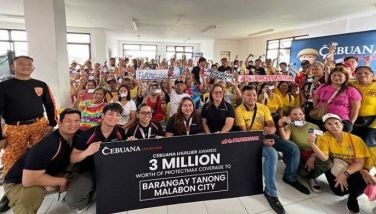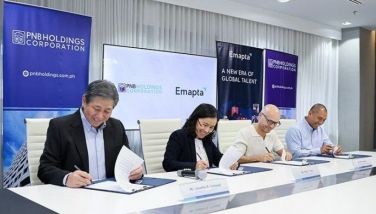Chongqing: City in a hurry to hit the big time
July 3, 2005 | 12:00am
Say Chongqing and some may recall that it was China’s wartime capital and the site of the famous but unsuccessful reconciliation talks between Chiang Kai-shek and Mao Zedong. A few may connect it with Wong Kar-wai’s 1994 art movie Chungking Express. But just as many might simply give you a quizzical look and say it sounds Chinese, but what or where is it really?
Chongqing is a charming city of hills and fog, sparkling high rises and and old country houses, bustling malls and little eateries tucked into limestone caves used as bomb shelters during the war–and no fat people.
Live in Chongqing for a couple of years, our guide tells us, and you’ll be fit and flab-free. That’s because walking is the norm in this City of Mountains, and that often means up and down hills and rises. Apartment buildings are built on mountain sides, and going home often means walking up and, in the older buildings of eight storeys or less, there are no elevators.
It’s also a natural sauna in the summer, being one of China’s three "furnace cities", with temperatures reaching well into the 40s. Located where the Jialing River empties into the great Yangtze and hemmed in by mountains on three sides, Chongqing’s unique topography shrouds it in fog most days in early spring and late autumn. But winters are mild, and spring and autumn days generally pleasant.
These days, Chongqing is making a big push for the big time. In 1997 it became the fourth municipality in China directly controlled by the central government (the other three are Beijing, Shanghai and Tianjin), 82,000 square kilometers in area consisting of most of the former eastern Sichuan province with a population of 32 million. It is poised to be the gateway and center of the development of China‘s vast western provinces, a role it will be even more suited to play once the Three Gorges Dam is completed in 2009 and cargo and passenger ships up to 10,000 tons can sail right into its port.
Such prominence is not new to Chongqing. After the old capital Nanjing fell in 1937, Chongqing became the capital and headquarters of Chiang Kai-shek’s Kuomintang regime, leading to extensive bombing by the Japanese that destroyed most of the city’s historical fabric. During the war, Shanhuba Island over which the Yangtze River Bridge now straddles was the site of the airstrip for the famous Flying Tigers of the US Air force. After the war, the city was the site of the famous but unsuccessful "Chongqing Talks" which sought reconciliation between Chiang’s Nationalists and Mao Zedong’s Communists.
But Chongqing’s history is much older, going back 3,000 years when it was the capital of the Ba kingdom before it fell to the Qin state in 316 BC. It was given its present name, which means "double celebration", by the Song Emperor Guangzong in 1189 to commemorate the fact that he was first made prince and later crowned emperor here. Chongqing was opened as a treaty port to British and Japanese traders in 1890.
Not surprisingly, Chongqing is an important center for industry, particularly chemicals, pharmaceuticals, mechanical and even weapons manufacturing. Lately, it has seen rapid development in other industries like tourism, communication and information technology. The convenience of land, air and water transport has also transformed Chongqing into a major center for agricultural production, particularly grain and pork.
One of the most important aspects of development for Chongqing is its tourism. Central to this is the fact that the municipality is the jump-off point for cruise tours of the great Yangtze River, the fabled Three Gorges and the majestic if controversial Three Gorges Dam.
Panda Travel, a Binondo-based tour operator that has been specializing in China packages for over a dozen years, has a new line-up of cruise tours and recently invited a group of travel agents and media representatives to check it out. Thankfully a day in Chongqing was included in our itinerary.
Sunday traffic in downtown Chongqing is busy but relatively quiet–as China traffic goes. This is because, our guide Wang tells us, there is a RMB200 fine for honking your horn–although implementation of this rule is obviously spotty. We visit the People’s Hall, a 4,000-seat auditorium that resembles the Temple of Heaven in Beijing, with a large park in front that was crowded with newlyweds posing for photos and kids on all fours painting their part in a long mural, watched over by meddling mothers and camera toting tourists.
Next we head up to Eling Park, but time limits do not allow us to explore it fully, which is a pity because we spotted some lovely gardens and what used to be embassy residences. The view of Chongqing from the view tower is ethereal, as the city’s fabled fog shrouded the Yangtze and Jialing Rivers and the bustling port below.
After lunch, the old town of Ciqikou is a delightful revelation. Over a thousand years old, you can actually see an old residential compound (with some strange and mean looking roosters in the central courtyard) with lovely antique furniture intact. Stroll through the alleyways for some interesting shopping: a lot of crafts and local delicacies, and a teahouse that has performances of the unique face changing act.
Back into town we are let loose at the Pedestrian Mall at the Liberation Monument, which is a delight to walk even for non-shoppers. The huge area is a maze of shops and markets and vendors and restaurants and multi-level department stores selling everything from 10-yuan t-shirts to the latest European designer goods.
Typical of Pinoy tourists, the shoppers among us come back laden with supots and a general complaint: so much to shop and so little time!
We are promised a typical Chongqing experience for dinner: hot pot and a cultural show, and both turn out to be sizzling. Even though we opt for the non-spicy broth, it contains enough zing to make the vegetables, meats and seafood one hot mouthful. The show of Chinese pop songs and revue-type dances is ear-splitting, and get us in the right mood to head out to the pier to board our ship for its nine o’clock sailing. The robust dinner is the perfect send-off for our three-day encounter with a legendary river, breathtaking scenery and an amazing feat of engineering.
Chongqing is a charming city of hills and fog, sparkling high rises and and old country houses, bustling malls and little eateries tucked into limestone caves used as bomb shelters during the war–and no fat people.
Live in Chongqing for a couple of years, our guide tells us, and you’ll be fit and flab-free. That’s because walking is the norm in this City of Mountains, and that often means up and down hills and rises. Apartment buildings are built on mountain sides, and going home often means walking up and, in the older buildings of eight storeys or less, there are no elevators.
It’s also a natural sauna in the summer, being one of China’s three "furnace cities", with temperatures reaching well into the 40s. Located where the Jialing River empties into the great Yangtze and hemmed in by mountains on three sides, Chongqing’s unique topography shrouds it in fog most days in early spring and late autumn. But winters are mild, and spring and autumn days generally pleasant.
These days, Chongqing is making a big push for the big time. In 1997 it became the fourth municipality in China directly controlled by the central government (the other three are Beijing, Shanghai and Tianjin), 82,000 square kilometers in area consisting of most of the former eastern Sichuan province with a population of 32 million. It is poised to be the gateway and center of the development of China‘s vast western provinces, a role it will be even more suited to play once the Three Gorges Dam is completed in 2009 and cargo and passenger ships up to 10,000 tons can sail right into its port.
Such prominence is not new to Chongqing. After the old capital Nanjing fell in 1937, Chongqing became the capital and headquarters of Chiang Kai-shek’s Kuomintang regime, leading to extensive bombing by the Japanese that destroyed most of the city’s historical fabric. During the war, Shanhuba Island over which the Yangtze River Bridge now straddles was the site of the airstrip for the famous Flying Tigers of the US Air force. After the war, the city was the site of the famous but unsuccessful "Chongqing Talks" which sought reconciliation between Chiang’s Nationalists and Mao Zedong’s Communists.
But Chongqing’s history is much older, going back 3,000 years when it was the capital of the Ba kingdom before it fell to the Qin state in 316 BC. It was given its present name, which means "double celebration", by the Song Emperor Guangzong in 1189 to commemorate the fact that he was first made prince and later crowned emperor here. Chongqing was opened as a treaty port to British and Japanese traders in 1890.
Not surprisingly, Chongqing is an important center for industry, particularly chemicals, pharmaceuticals, mechanical and even weapons manufacturing. Lately, it has seen rapid development in other industries like tourism, communication and information technology. The convenience of land, air and water transport has also transformed Chongqing into a major center for agricultural production, particularly grain and pork.
One of the most important aspects of development for Chongqing is its tourism. Central to this is the fact that the municipality is the jump-off point for cruise tours of the great Yangtze River, the fabled Three Gorges and the majestic if controversial Three Gorges Dam.
Panda Travel, a Binondo-based tour operator that has been specializing in China packages for over a dozen years, has a new line-up of cruise tours and recently invited a group of travel agents and media representatives to check it out. Thankfully a day in Chongqing was included in our itinerary.
Sunday traffic in downtown Chongqing is busy but relatively quiet–as China traffic goes. This is because, our guide Wang tells us, there is a RMB200 fine for honking your horn–although implementation of this rule is obviously spotty. We visit the People’s Hall, a 4,000-seat auditorium that resembles the Temple of Heaven in Beijing, with a large park in front that was crowded with newlyweds posing for photos and kids on all fours painting their part in a long mural, watched over by meddling mothers and camera toting tourists.
Next we head up to Eling Park, but time limits do not allow us to explore it fully, which is a pity because we spotted some lovely gardens and what used to be embassy residences. The view of Chongqing from the view tower is ethereal, as the city’s fabled fog shrouded the Yangtze and Jialing Rivers and the bustling port below.
After lunch, the old town of Ciqikou is a delightful revelation. Over a thousand years old, you can actually see an old residential compound (with some strange and mean looking roosters in the central courtyard) with lovely antique furniture intact. Stroll through the alleyways for some interesting shopping: a lot of crafts and local delicacies, and a teahouse that has performances of the unique face changing act.
Back into town we are let loose at the Pedestrian Mall at the Liberation Monument, which is a delight to walk even for non-shoppers. The huge area is a maze of shops and markets and vendors and restaurants and multi-level department stores selling everything from 10-yuan t-shirts to the latest European designer goods.
Typical of Pinoy tourists, the shoppers among us come back laden with supots and a general complaint: so much to shop and so little time!
We are promised a typical Chongqing experience for dinner: hot pot and a cultural show, and both turn out to be sizzling. Even though we opt for the non-spicy broth, it contains enough zing to make the vegetables, meats and seafood one hot mouthful. The show of Chinese pop songs and revue-type dances is ear-splitting, and get us in the right mood to head out to the pier to board our ship for its nine o’clock sailing. The robust dinner is the perfect send-off for our three-day encounter with a legendary river, breathtaking scenery and an amazing feat of engineering.
BrandSpace Articles
<
>
- Latest
- Trending
Trending
Latest
Trending
Latest
Recommended



















